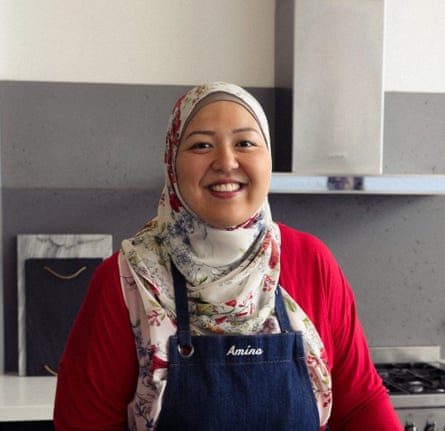
Haemultang is a deliciously wholesome Korean soup, made from a combination of shellfish and fish, simmered in a spicy broth. Quite often it is cooked in a heavy stone pot that retains its heat at the table; but sometimes it is served bubbling over a portable stove, especially when there’s a crowd to feed.
This already wonderful dish is even more special for me, as it holds sentimental memories – both of the home I grew up in and travel to my mother’s homeland.
My mother is Korean and my father is Egyptian. They met in Riyadh in the 1970s when they were both working as expats in Saudi Arabia, my mother as a nurse and my father as an accountant. Theirs was a mixed marriage, which they say was actually quite common at the time. Saudi Arabia was opening up to the outside world, and lots of expats and cultures mixed together.
With immigration and expat workers, there’s an estimated 100,000 Muslims in South Korea. The majority live in Seoul, where my mum grew up and my grandmother still lives, but there are also a few mosques around the country. Since 2004, the Ministry for Foreign Affairs has actually held an annual Iftar during Ramadan.
But, 40 years ago, when my mum was growing up, Islam didn’t really exist in Korea. She learned a lot about it, living in Saudi and meeting my dad, and she converted.
For me, it’s a great privilege having two different heritages. It means visiting extended family in both countries, and being able to inherit two very different cuisines. I think for my parents it’s been enriching too. Dad does lots of interfaith work.
There is no set recipe for Haemultang in Korea, although the broth is generally made with gochujang (fermented chilli paste), gochugaru (dried chilli flakes or powder) and a fragrant seafood, anchovy or beef stock.
When my mother used to make her version, she often used blue swimmer crabs, prawns and whichever white-fleshed fish fillets were fresh from the local seafood shop.
There is no prerequisite for the type of seafood used. It can vary depending on what you personally like or what’s available – though a variety of shellfish is always recommended, as the shellfish will intensify the flavour of the broth as it cooks.
When I travelled to South Korea in 2014, I visited Busan, the seafood capital, and had a ridiculously good pot of haemultang, which reignited my love for it. Then in 2016, my husband and I travelled to Seoul on our honeymoon. Our first dinner was haemultang! Both versions had exotic shellfish like abalone and sea snails.
My version of haemultang is inspired by my experience in Busan. I find that the combination of crab, pipis, prawns, mussels and a firm white-fleshed fish such as ling make a fabulous broth.
Head to your local Korean grocer to get your hands on gochujang (the fermented chilli paste), and gochugaru (the dried chilli flakes or powder) – and if you’re not too keen on a very spicy broth, use a little less of these ingredients. The chrysanthemum leaves are used a lot in Korean, Chinese and Vietnamese cuisines and can be found at pretty much any Asian grocer.
And remember, there are no real rules. Take the opportunity to travel to your local fish market, ask them what is good at the moment and explore your local seafood varieties. You can’t go wrong, and you may end up trying some new and delicious seafood for the first time.
Amina’s haemultang (spicy seafood stew)
1L of good quality stock (seafood, dashi, anchovy or vegetable stock all work)
2 blue swimmer crabs, cleaned and halved
1 dozen mussels, debearded and cleaned
16 vongole or pipis, cleaned
8 king or large banana prawns left whole
500g ling fillet, (or similar firm white fillet) deboned and skin removed
250g firm tofu, sliced into roughly 1cm x 3cm x 3cm blocks
¼ medium onion, sliced thinly
½ tsp minced ginger
¾ tsp minced garlic
1tbsp coarse gochugaru (dried chilli flakes or powder)
1 ½ tbsp gochujang (fermented chilli paste)
1 tbsp all rounder soy sauce
1 tbsp finely sliced green onions
Small bunch of chrysanthemum (crown daisy) leaves
200g enoki mushrooms, sliced off at base
Cooked medium grain rice, to serve
Mix the seasoning ingredients until well combined and leave aside.
In a semi-shallow stone/clay pot (use one with a lid), bring your stock of choice to the boil. While waiting for the stock to boil, ensure that all the prepared seafood has any excess moisture dried off with a paper towel. Slice the ling fillet into 3cm cubes.
Once the stock is boiling, lower the heat to a simmer. Carefully arrange the tofu, sliced onions, fish fillets and the remaining seafood, then increase to high heat and cover. Cook for three to five minutes until the seafood is just cooked. Ensure that all the mussels and vongole or pipis have opened – if there are any that have not, discard.
Just before serving, arrange the chrysanthemum leaves and enoki mushrooms over the centre of the haemultang. Serve immediately with individual portions of hot rice.
-
Amina Elshafei is a paediatric nurse, wife, mum and passionate cook who loves travel and exploring different cultures. She is a two-time MasterChef contestant, and her cookbook Amina’s Home Cooking is a homage to the Egyptian and Korean food she grew up eating.
-
You can find this recipe and other Australian-Muslim recipes and stories on the Recipes for Ramadan website; and follow the project on Instagram, Facebook and YouTube.



